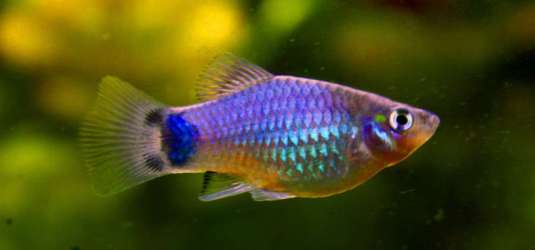03 Jan 2020
by litzi2015
in Aquarists' Blog, Aquarists' Online Journal, Aquarium Hobbyist Blog, Aquarium Keeping Blog, Aquarium Online Journal, Divided Aquariums, Freshwater Aquarium Blog, Home aquarium blog, Pet fish blog, Planted Aquarium Blog, Tropical Fish Aquarium Blog, Tropical Fish Online Journal, Uncategorized
Tags: alpha male, animal fighting, Aquabid, behaviorism, betta splendens, bettas, bullying, buying fish online, depression, Divided aquarium, divided tanks, eBay, extinguishing aggressive alpha male behaviors, fighting fish mythology, grief, quarantine, rare betta colors, territory, varied diet
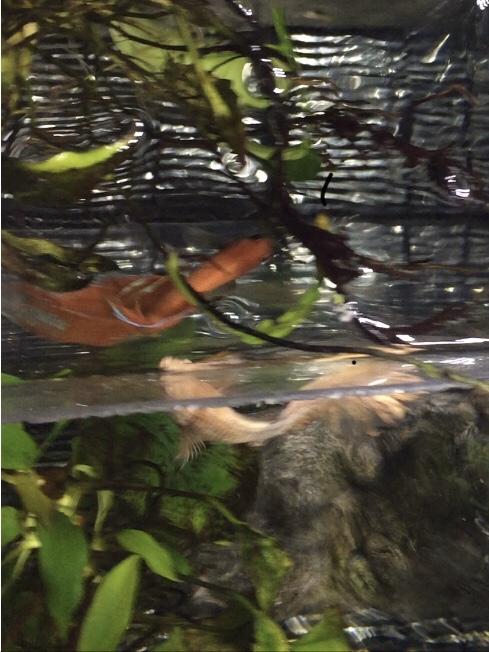
This is from a video taken on Nov. 9, 2018. The orange guy is Apricot and the yellow guy is Honey. The video shows them swimming in tandem in the betta rainbow.
In keeping my betta rainbow, I’ve found that bettas can be quite variable in their life spans, behaviors and temperaments. Through trial and error I’ve refined not only the tank setup but plants, filtration, lighting, and increased variability in their diet. I’ve also learned about their behavior, the importance of their social fabric and bonds with one another. I have learned how to prevent lengthy vacancies in the betta rainbow. It isn’t about maintaining a particular “look” or stocking in spite of the fish’s needs. And it isn’t about them being interchangeable, because they’re not. It’s about preventing a healthy fish from going into a depressed funk because he lost his best friend. I’ve seen this happen. A depressed fish will stop eating, hide or face the back of the tank and within a week or two he dies.
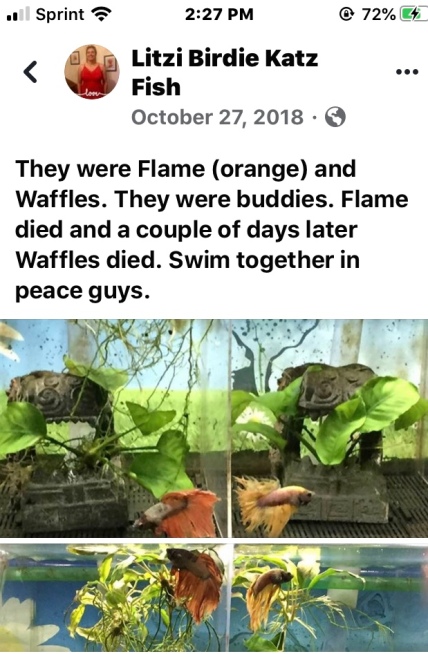
A Facebook post showing Flame and Waffles in the betta rainbow.
If a particular fish is elderly or in failing health, I will get a same color betta, quarantine him, and keep him in in a separate setup so he’s ready when his predecessor passes. I’ve ordered bettas on eBay, which can enable me to get a betta in a specific color (especially a rare color) more expediently than going from pet store to pet store. Aquabid.com is also another online source for buying fish, but I’ve found those fish tend to be pricier and typically imported from Asia, whereas on eBay they’re more reasonably priced and I can more easily find US based vendors.
Now, would I keep several bettas in an undivided community setup? No. The reason why is they can vary considerably in their temperament, agility and swimming speed. Older bettas are also more sedate than younger ones. The dividers ensure everyone has equal territory and equal access to food. It prevents anyone from bullying or being bullied. So even if a betta comes in with real alpha male tendencies, if he starts flaring and trying to chase his neighbors, they can safely ignore him. And they do. Before too long he realizes that his attempts at showing dominance gain him nothing, so the behavior stops. Behaviorism 101 is that behavior that’s rewarded is repeated. Behavior that’s not rewarded is eventually extinguished. This is precisely how we train any animals including other humans.
When I get a new betta I put him in a 1-2 gallon quarantine tank and I position it next to another tank. When I had the betta rainbow on my kitchen counter I placed the quarantine tank next to it. Now I have a 4 gallon single betta tank and a 10 gallon with Monterrey platies and guppies, so the quarantine tank goes there. They’re usually quarantined for 7-10 days and if they showed any dominance behaviors before those behaviors are usually gone before they join the betta rainbow. In fact the way most retail pet stores keep bettas also serves to extinguish alpha male behavior. They are kept in clear plastic same size cups in sight of one another. If they show alpha male behavior it gains them nothing in terms of food or territory. So the behavior is extinguished.
Contrary to the “Siamese fighting fish” mythology, bettas are not mindless killing machines. In southeast Asia they were bred and conditioned to fight. They were kept in complete isolation in clay jars and only saw another betta in a fight situation. They were treated in a comparable manner to fighting dogs and fighting roosters. Dog fighting and rooster fighting are outlawed in all 50 US states and are seen and treated as the atrocities that they are.
I am a therapist, and years ago a co-worker of mine said to me: “I hate it when parents cause a particular problem in a child and then blame the child for having the problem that they themselves caused.” Think of an obese child whose parents scorn him for his obesity but feed him nothing but lots of high calorie junk food. Or the parents who resent their child’s asthma and frequent respiratory infections when they both chain smoke in the house and around the child. Let’s not blame bettas for a problem that humans caused.
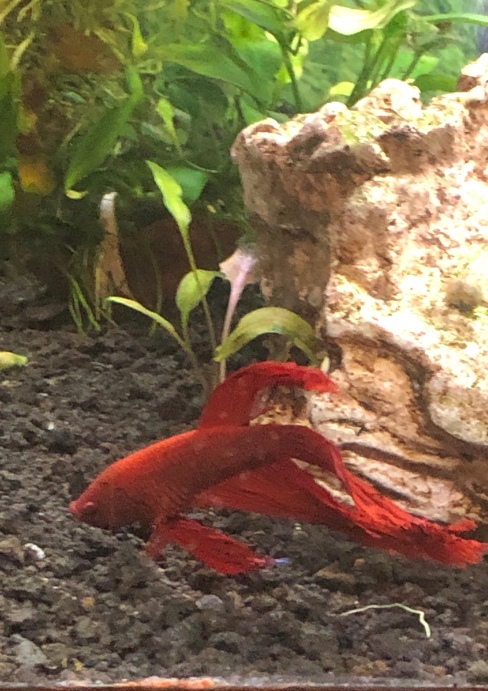
In the red section of the betta rainbow is Scarlet. He joined us Oct. 6, 2019.
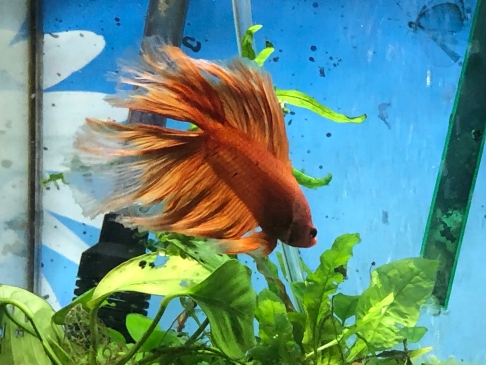
In the orange section is Mandarin II. He joined us Sept. 1, 2019.
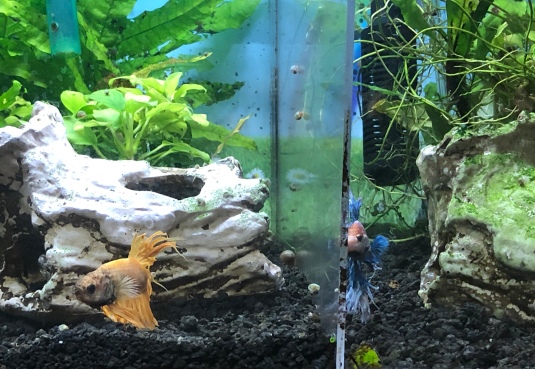
In the yellow section is Topaz, to the left. He joined us on Nov. 2, 2018. To the right is White Forest.
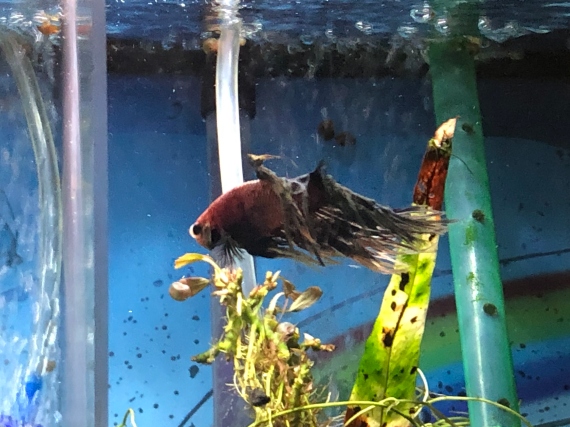
In the green section is White Forest. He joined us Sept. 1, 2019.
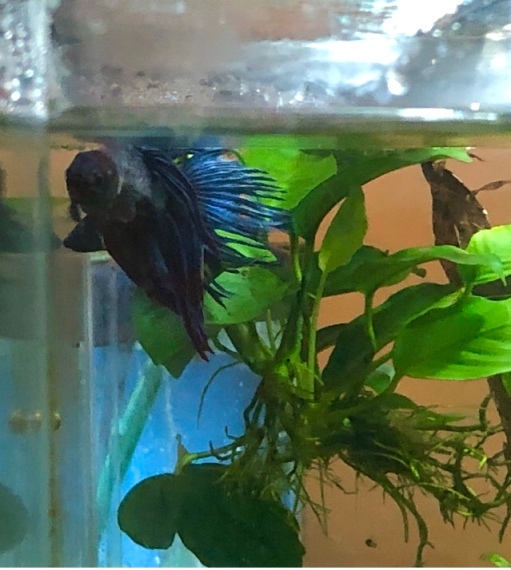
In the blue section is Royal II. He joined us Nov. 1, 2019.
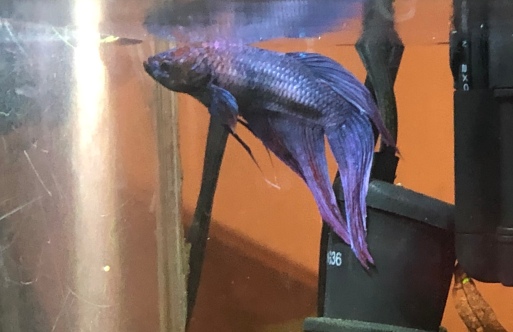
And last but not least, in the purple section is Prince. He joined us Nov. 1, 2018. We have had him the longest.
06 Jul 2019
by litzi2015
in Aquarists' Blog, Aquarists' Online Journal, Aquarium Hobbyist Blog, Aquarium Keeping Blog, Aquarium Online Journal, Fish tank blog, Freshwater Aquarium Blog, Home aquarium blog, Keeping Livebearers, Pet fish blog, Tropical Fish Aquarium Blog, Tropical Fish Online Journal, Uncategorized
Tags: Ammonia, aquarium lids, Breeding fish, Chemistry, Cycling, Decor, filters, heaters, illness, injury, invasive species, jumping, Level, life support, maintenance, Money, New Aquarists, New Tank Syndrome, Nitrates, Nitrites, online shopping, overstocking, prevention, Quarantine new fish, rehoming, shipping live fish, social media, species compatibility, USPS, water weight
A-Ask questions: Don’t be afraid to ask questions or look up information.
B-Birth Control: Some fish breed more readily in captivity than others. Livebearers, such as guppies, mollies and platies can be fish baby-making machines. If you want to prevent this, keep either all males or all females or separate them. If you end up with babies, some pet stores will accept fish (Petsmart and Pet Supplies Plus will NOT, Petco may). You can also sell them online via eBay or www.aquabid.com . See Rehoming, Too Many Fish.
C-Chemistry and Cycling: Read up on water chemistry, beneficial bacteria and the nitrogen cycle before getting fish.
D-Decor: Aquarium décor is both decorative and functional. Fish need places to rest and hide. An interesting, enriched environment reduces stress and prevents boredom and aggression. Just make sure any décor added is aquarium safe.
D-Dumping and Flushing: DO NOT DUMP fish or plants in a natural waterway ever! This can spread disease and/or introduce invasive species. DO NOT FLUSH a live fish ever! It is inhumane! For more info go to http://www.transportzero.org/release-zero.html or http://takeaim.org/takeback/networks/il/
E- Extras: It’s always good to have a spare heater and filter in case you have an equipment failure. Heat and filtration are life support. Having extra can save your fish’s lives and can save you from having to pay full retail for a filter or heater.
F-Filtration: This is a necessity. More is better. Make sure the filter is sufficient for your size tank.
G-Google: Google can be a fish’s or aquarist’s best friend. It’s the place to go for looking for information.
H-Heat: Apart from goldfish, most commercially available freshwater fish need heat, and that includes bettas! A heater is a must!
I-Illness and/or Injury: The best source I’ve found is Manual for Fish Health. Online, americanaquariumproducts.com has a lot of useful information, especially about medication.
J-Jumping: Some fish will jump out of aquariums. Aquarium lids keep things out and the fish in.
K-Keeping Up: Keeping up a fish tank doesn’t have to be a lot of work. A little maintenance done often is key. Don’t wait for problems to get big or the tank to get really dirty before you clean it.
L-Level: Make sure your tank is level. If it’s not, it can become a tipping hazard.
M-Money: Fish keeping has the reputation of being a budget busting hobby, but it doesn’t have to be. Watch for sales. Buy non-perishable items in bulk. Buy second-hand or trade. Find a local hobbyist club and/or swap meets.
N- Nitrates and Nitrites: These are the by-products of the breakdown of fish waste. They are NOT your fish’s friend! Newly set up tanks can experience New Tank Syndrome, which is a spike first in ammonia, then nitrite then nitrate. See Chemistry and Cycling.
O-Online shopping: Unless they’re on sale, food, water additives, lights, heaters and filters in a brick and mortar store are much more expensive than those same items online. You will also be able to find things online that you won’t see in a store. Some of my favorite places are amazon warehouse deals, eBay, pet mountain and even petco.com and petsmart.com will have deals that the brick and mortar stores won’t.
P-Prevention: Many fish keeping problems can be prevented and/or avoided. Be proactive. Seek out information. Don’t skimp on water changes. Treat illnesses or injuries sooner versus later. Quarantine. Don’t overstock. Make sure species are compatible before adding. See Too Many Fish.
Q-Quarantine: ALWAYS ALWAYS ALWAYS quarantine new arrivals! For at least one week, better 10 days to 2 weeks. If using an uncycled, new quarantine tank, test for ammonia, nitrates and nitrites daily or do 30-50% water changes every day or 2.
R-Rehoming: If you need to rehome fish, please do so responsibly. Check local pet stores to see if they’ll take them. List them online. Sell or give them away via eBay or www.aquabid.com See Dumping and Flushing.
S-Social media: Facebook and Instagram can be great sources of support and information. Two of my favorite groups are Fish Tank Enablers and Fish Tank Obsession.
T-Too Many Fish: An overstocked tank can be hard to care for and the fish can become stressed and sick. Aggression can result. Www.aqadvisor.com is an excellent resource to check stocking levels and species compatibility.
U-USPS: Believe it or not, you can ship live fish via USPS using Priority Mail. There is information online about how to ship fish safely.
W-Weight: Fresh water weighs 8 pounds a gallon, so a 10 gallon tank will weigh at least 80 pounds. If you include the weight of the tank itself, gravel, equipment etc. round up to 10 pounds per gallon. The best bet is to use an aquarium stand because it was designed to hold the weight of an aquarium. If you want to put a tank on some other piece of furniture, like a dresser or table, ask yourself if this piece of furniture would support the weight of one or more adults safely, 24/7/365.
06 Jul 2019
by litzi2015
in Aquarists' Blog, Aquarists' Online Journal, Aquarium Hobbyist Blog, Aquarium Keeping Blog, Aquarium Online Journal, Endangered Fish Blog, Fish hobbyist clubs, Fish tank blog, Freshwater Aquarium Blog, Home aquarium blog, Keeping Livebearers, Pet fish blog, Tropical Fish Aquarium Blog, Tropical Fish Online Journal, Uncategorized
Tags: American Livebearer Association, breeding livebearers, jeweled, leopard, lyonsi, Monterrey, platy, splitfin, xenotoca
The pregnant Monterrey platy girl mentioned in the last post ended up having about 30 babies between December 2018 and March 2019. In mid May I gave 7 juveniles to Chris Neal and I sold 10 juveniles at the American Livebearer Association convention in Louisville, KY. I kept 2 females in the original mother lode tank, I put one pair in the kitchen 10 gallon and another pair in the foyer 10 gallon. In my family room I put 4 young males in one ten gallon, and an adult male and 6 unsexed babies in the other. 5 of the 6 unsexed babies turned out to be female, and now they are all pregnant. So right now I have a total of 17 Monterrey platies, 9 of which are pregnant females. I’m hoping in the next couple of weeks to have lots of babies.
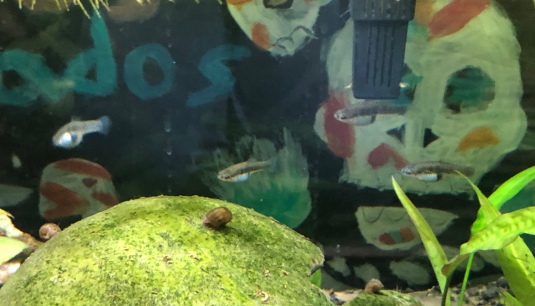
4 pregnant Monterrey platies, July 2019.
My goodeids have done well too. I traded 6 jeweled splitfin juveniles for some plants with a hobbyist in Omaha and I sold 6 jeweled splitfins and 4 leopard splitfins with a hobbyist in Alabama. In addition to the Monterrey platies, I sold 7 jeweled splitfin juveniles and 8 xenotoca lyonsi at the ALA convention. Right now I have about 12 xenotoca lyonsi, 5 of which are male, and all the females are pregnant. I have about 20 leopard splitfins, with 2 big alpha males and the rest pregnant females. I have about 10 jeweled splitfins, 2 are big males, 2 are hugely pregnant females, and the rest juveniles and babies.
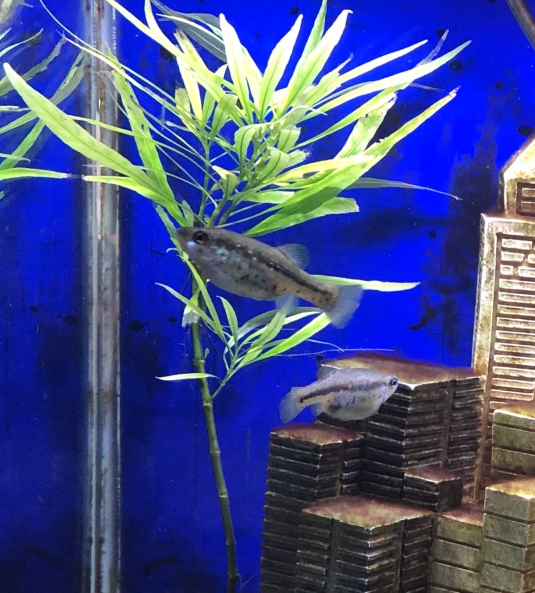
2 pregnant jeweled splitfins, July 2019.
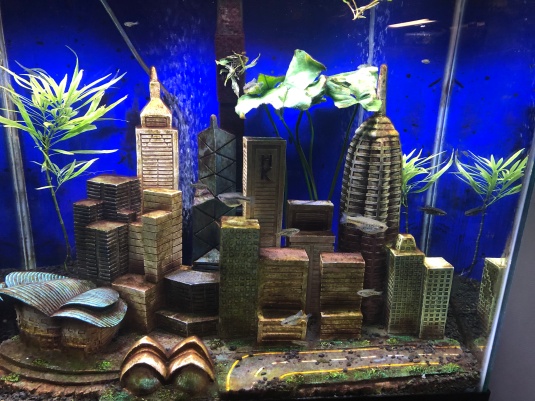
Jeweled splitfins, July 2019.
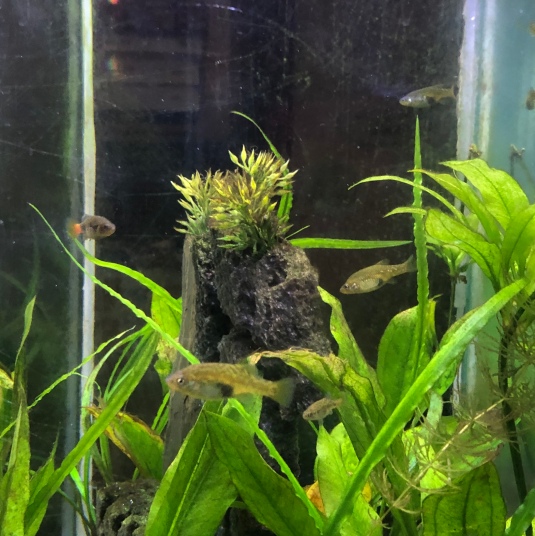
Xenotoca lyonsi in the newly rehabbed 30 hexagon tank, July 2019.
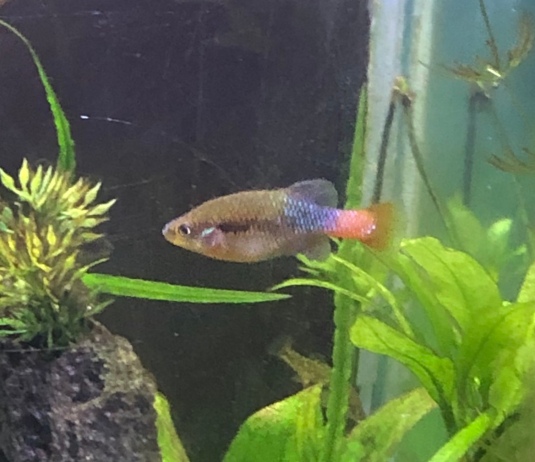
Male xenotoca lyonsi, July 2019.
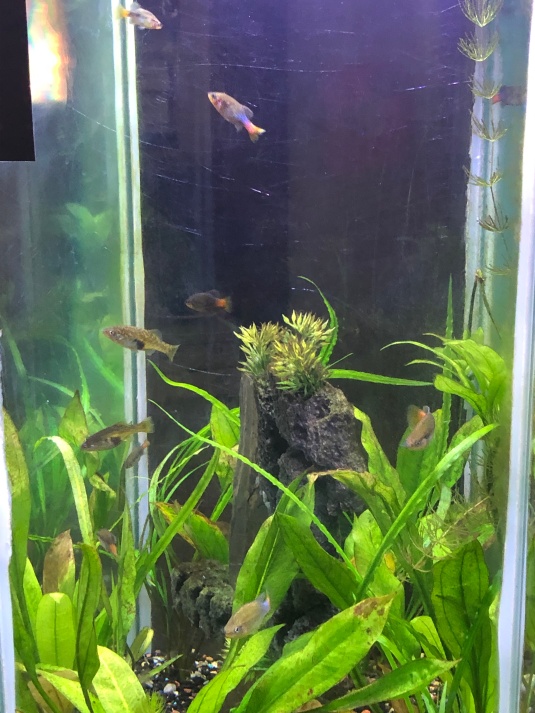
Xenotoca lyonsi, July 2019.
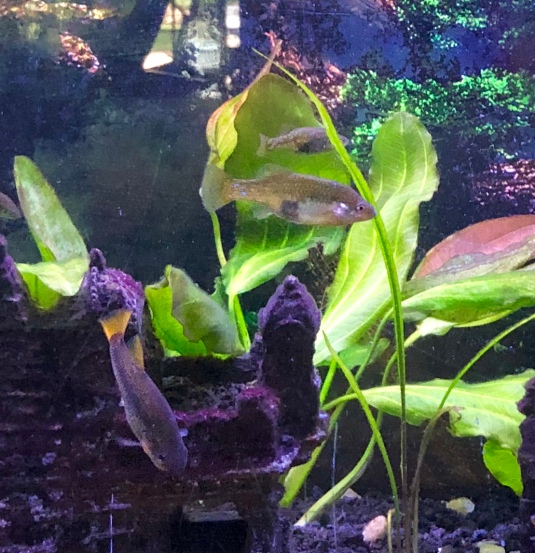
Leopard splitfin male and 2 pregnant females, July 2019.
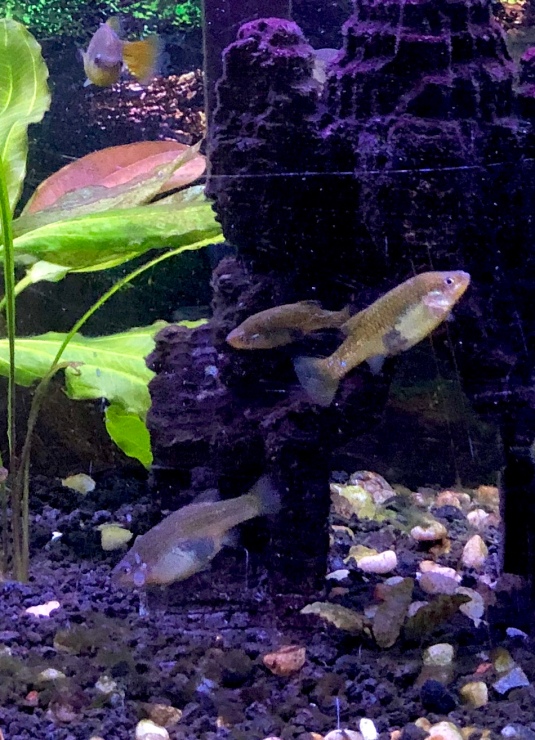
Pregnant Leopard splitfins, July 2019.
18 Mar 2019
by litzi2015
in Aquarists' Blog, Aquarists' Online Journal, Aquarium Hobbyist Blog, Aquarium Keeping Blog, Aquarium Online Journal, Endangered Fish Blog, Fish hobbyist clubs, Fish tank blog, Freshwater Aquarium Blog, Home aquarium blog, Keeping Livebearers, Pet fish blog, Planted Aquarium Blog, Tropical Fish Aquarium Blog, Uncategorized
Tags: Aquabid, Aquashella, Chicago Livebearer Society, Endangered livebearers, extinct in the wild livebearers, goodeids, hexagon tanks, Monterrey platies, pregnant female fish, South park characters, ten gallon tanks
I can tell how crazy my life gets by how long I go between blog posts. There have been so many things going on since May 2018, both fish and non-fish related. Non-fish related, my oldest daughter Larissa, who started my whole aquarium hobby when she lost interest in her 15 gallon tank, graduated high school and went away to college. My daughter Naomi’s interests in playing volleyball and cello for her school orchestra, blossomed. At work we started having many staffing and policy changes which ultimately led to me finding a new job this spring. Fish related, I have 1 new tank, one of which I got at Aquashella in August 2018 for volunteering. Of wild type and/or rare and/or endangered fish, I now have established groups of limia sp. tiger, poecilia cf obscura, Monterrey platies and some goodeids–leopard splitfins, xenotoca lyonsi and xenotoca variata, or the jeweled splitfin.
My female Monterrey platy arrived from Peoria, courtesy of Chris Neal, as did my Monterrey platies from Aquabid. After being appropriately quarantined in 10 gallon tanks, I moved everyone into my 30 gallon hexagon tank.
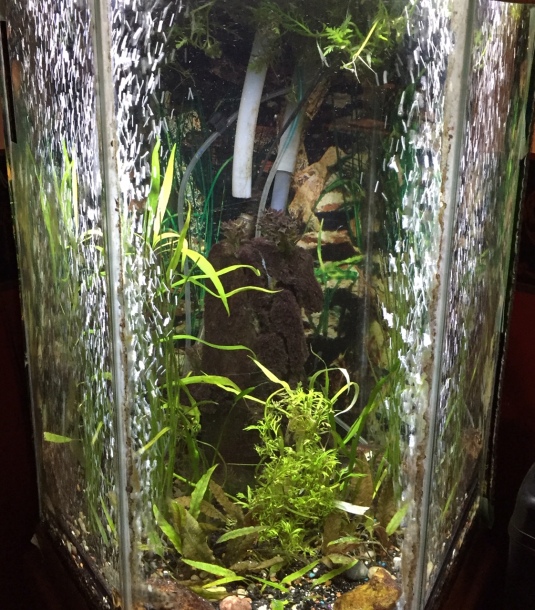
The 30 gallon hexagon tank, September 2018.
I chose the 30 hexagon because it had a history of being a baby factory. I had northern mountain swordtails and limia sp. tiger overrun this tank. At first they all seemed to do well. I had some pregnant females and even saw a few fry. I found four fry when emptying out the quarantine tank that housed the girl who came from Chris Neal. But they didn’t seem to thrive in the 30 hex. At best the adults lasted a few weeks. Meanwhile the water values were fine. I thought maybe I had a batch of genetic weaklings, so I ordered some more fish from a different Aquabid seller. In October 2018 I got a pair and some fry from the Chicago Livebearer Society member auction.
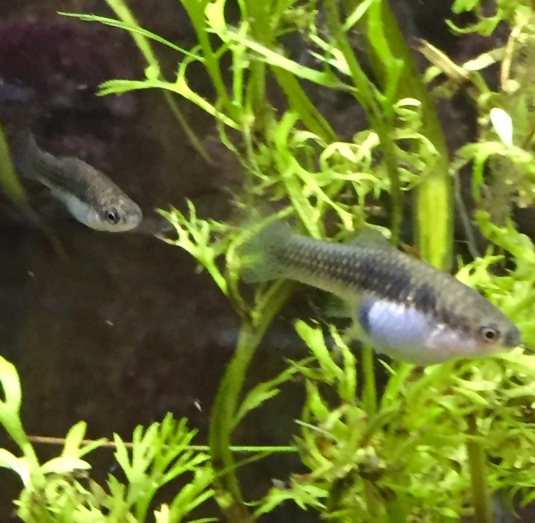
A pregnant female Monterrey platy with a young male close behind, September 2018
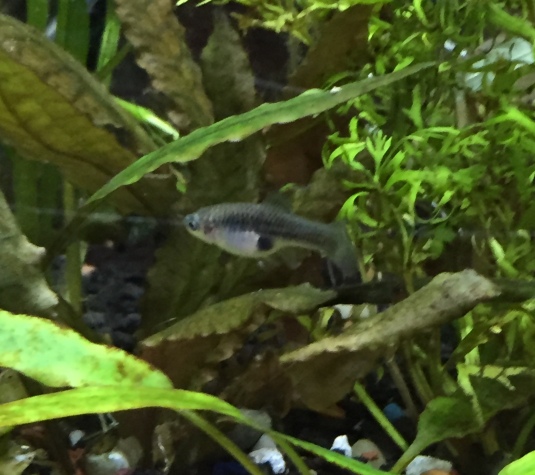
A pregnant female Monterrey platy, September 2018
These fish appeared to do better than my previous ones. But I ended up with a really lopsided gender ratio. I had five males and two females, one was pregnant and the other was a juvenile. I noticed pregnant girls were ruthlessly harassed by males, often to their deaths. The males appeared to have a ringleader, a big fat bully I named Cartman. His friends got named Kyle, Stan, Kenny and Butters. So I divided them up. The pregnant girl went in a heavily planted 10 gallon. The juvenile girl was put in another planted 10 gallon with the runt of the males, Kenny. The other four males were divided and two pairs went into two ten gallons. So what would happen??? Stay tuned.
12 May 2018
by litzi2015
in Aquarists' Blog, Aquarists' Online Journal, Aquarium Hobbyist Blog, Aquarium Keeping Blog, Aquarium Online Journal, Endangered Fish Blog, Fish hobbyist clubs, Fish tank blog, Freshwater Aquarium Blog, Home aquarium blog, Keeping Livebearers, Pet fish blog, Tropical Fish Aquarium Blog, Uncategorized
Tags: adaptation, American Livebearer Association, Aquabid, breeding endangered fish, Endangered livebearers, goodeid working group, Mexico, Monterrey platies, Shipping fish, Tequila splitfin, Tropical fish, Xiphophorus couchianus, Zoogoneticus tequila
Last weekend I was at the American Livebearers Association annual convention in Grand Rapids MI. I had a wonderful time. The ALA is doing some amazing working protecting vulnerable species by teaming aquarium hobbyists with scientists and conservationists. The idea is to maintain different species groups in as many places as possible. This helps protect genetic diversity and prevents the loss of an entire species if disease, accident or natural disaster strikes in one population. The goal is to ensure species survival until they can be reintroduced into the wild. This has actually happened with one species of fish, Zoogoneticus tequila or the tequila splitfin. It went extinct in its local habitat and literally the only members of the species on earth were in aquariums.
http://www.goodeidworkinggroup.com/sites/default/files/Articulo%20general-Final-26-Julio-2016.pdf
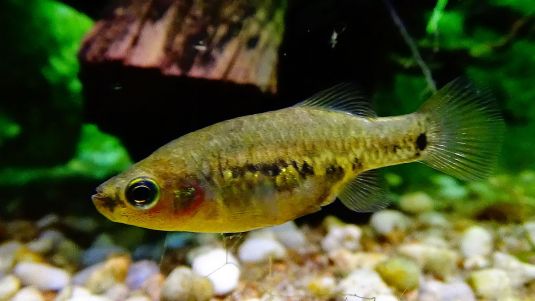
Male tequila splitfin, photo courtesy of Wikipedia.
I was delighted when I managed to obtain a pair of Monterrey platies, a fish now gone from its native habitat. They are native to the Huasteca canyon in Monterrey, which used to hold a sizeable body of water but has since been drained dry. I had gotten some Monterrey platies a few years ago, and I wanted to keep them again. I was delighted when I got a pair! When I got back from Grand Rapids and unpacked my things, I was devastated to find my female dead. I got busy networking with some other nearby aquarists who keep rare livebearers. They are on Facebook as the Freshwater Fish Preservation Aquarist Team. One member said he could send me two females. I had always been wary of fish being shipped, but these fish were in Peoria and I live in Naperville. So it was either shipping or a 5 hour roundtrip driving. Shipping it is.
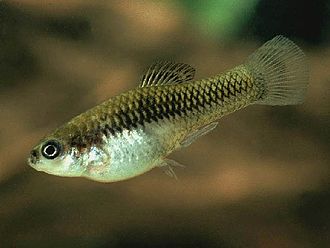
Male Monterrey platy, courtesy of Wikipedia.
I had never been on Aquabid before, but now that I’d cleared the mental hurdle of shipping fish, I decided to check it out. Aquabid is the ebay of live fish, and is the site that many serious fish breeders and collectors use to buy and sell fish. I found an auction for 1 pair and 6 juveniles. And I won! So once everybody arrives and clears quarantine, my lonely male will have 10 new friends–2 new girlfriends, another pair and 6 juveniles. All is not lost!
Wildlife conservation is something that can stir at our hearts but it can seem remote and/or not feasible. Who can or should keep a white rhino, Siberian tiger, panda or snow leopard in their house or yard? No one. We can give money, but it seems so disconnected from the outcome. This is one way we can literally save endangered species. With endangered wild type livebearers, they aren’t any harder to keep than pet store type fish. And since most do best in single species setups, you don’t need a large tank. A 10 or 20 gallon would do just fine. The important thing is to make sure there are plenty of (real or artificial) plants and hiding places for fry if you’re not putting them in a separate tank.
You might be wondering, why the Monterrey platy? It’s not a particularly spectacular looking fish. I think their beauty is understated elegance. This fish disappeared because humans literally drained its home dry. Often to some degree some fish species can adapt to pollutants or temperature changes. NO fish can adapt to no water any more than we humans can adapt to no air.
My fish from Peoria should arrive Tuesday. I imagine my Aquabid fish will arrive next week as well.
24 Apr 2018
by litzi2015
in Aquarists' Blog, Aquarists' Online Journal, Aquarium Hobbyist Blog, Aquarium Keeping Blog, Aquarium Online Journal, Fish hobbyist clubs, Freshwater Aquarium Blog, Home aquarium blog, Keeping Livebearers, Pet fish blog, Planted Aquarium Blog, Tropical Fish Aquarium Blog, Tropical Fish Online Journal, Uncategorized
Tags: aquarium society, Family pets, Filtration, fish swap meet, Florida, invasive species, livebearers, Mexico, natural waterways, non-native species, pet store, platies, Tropical fish, wild caught fish
One sad reality of our modern life is we lose touch with nature. Eggs come from cartons, milk comes from gallon jugs, and fruits and vegetables come from the produce section of the grocery store. And pet fish come from the pet store. Once human beings start cultivating or farming anything, whether corn, strawberries, turkeys or fish, they start selecting for the traits they deem desirable and before too long the cultivated or farmed plants or livestock bear little semblance to their wild counterparts. I have a few wild strawberries in my yard. My brother, who lives in western Virginia, has hunted wild turkey (the bird not the whiskey) for Thanksgiving dinner. But as most aquarium fish are tropical, how many of us have seen them in their native habitat? In early March I had the opportunity to do so. I went with a group of fish hobbyists to San Luis Potosi Mexico in early March. It was amazing, but I’m saving that topic for another post.
Another side effect of humans cultivating anything is the introduction of non-native and invasive species. Whether it’s Asian carp taking over the Mississippi, kudzu spreading through the south, lionfish decimating the shrimp population off the Carolinas, or boa constrictors loose in Florida, it’s a huge environmental problem. Unfortunately, there are irresponsible aquarium keepers who dump their unwanted fish in natural waterways. If you dump tropical fish in an Illinois waterway they won’t survive the winter. But in the southern U.S., it’s another story.
In March I attended a swap meet hosted by the Green Water Aquarium Society and one of the vendors had wild caught platies. Platies are native to Mexico. But he didn’t catch them in Mexico, he caught them in Gainesville, Florida. They were clearly the descendants of unwanted aquarium fish, but they didn’t look like any platies I’ve seen in pet stores.
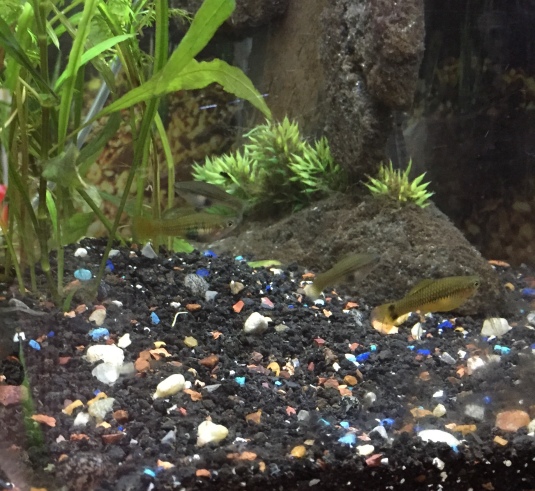
Three pregnant female wild caught platies, April 2018
Within a few generations, natural selection weeds out the traits, like bright colors, that humans selected for. However, the girl on the right shows the two black vertical dots that fish breeders transformed into the Mickey Mouse marking.
My plan is to add these girls or their babies to my tank with captive born platies. This will add some hardiness and variability to their gene pool.
Watch this space…
21 Apr 2018
by litzi2015
in Aquarists' Online Journal, Aquarium Hobbyist Blog, Aquarium Keeping Blog, Aquarium Online Journal, Fish hobbyist clubs, Fish tank blog, Freshwater Aquarium Blog, Home aquarium blog, Keeping Livebearers, Pet fish blog, Planted Aquarium Blog, Tropical Fish Aquarium Blog, Tropical Fish Online Journal, Uncategorized
Tags: albino corydoras catfish, blackline rasboras, emerald catfish, fish longevity, julii catfish, planted aquariums, tetra glofish, upside down catfish
In the U.S., the Constitution states that we are to take a census every 10 years. This helps determine the number of representatives in Congress and assess relative need for federal tax dollars. Periodically I take a fish census.
Since early 2014 I have kept records of fish acquired, fish deaths, and which fish are in what tanks. When I started giving away significant numbers of fish to Chicago Livebearer Society, I kept note of that too.
I’ve done this for a number of reasons. Fish longevity and mortality are good indicators of the health of the tank. If fish are dying off quickly, then something is obviously wrong. The tank is poorly cared for and/or overstocked. A disease was introduced. Tankmates are incompatible. Or the tank conditions are not matched to the needs of the fish species. There is also this perception that fish are “disposable”. It’s true that some species by nature have a relatively brief lifespan–neon tetras and killifish come to mind. They live a few months or a year at best. Livebearers and catfish should live longer than that. Properly housed and cared for, goldfish can lives for years and koi can live for decades.
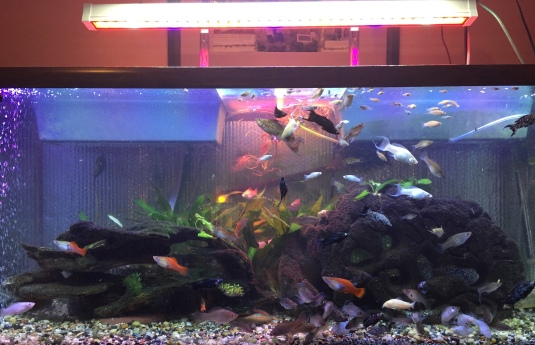
My 75 gallon tank, February 2018
My 75 gallon tank is home to some longevity superstars. In the lower right you will see an albino cory catfish. I have two in this tank, Snowcat and Cloudcat. I bought them 10-25-14, so I have had them 3 1/2 years. Also in that tank are 3 zebra loaches I bought 6-14-15 and 1 yo-yo loach, bought 10-29-15. There was a second yo-yo loach, who jumped to his death recently.
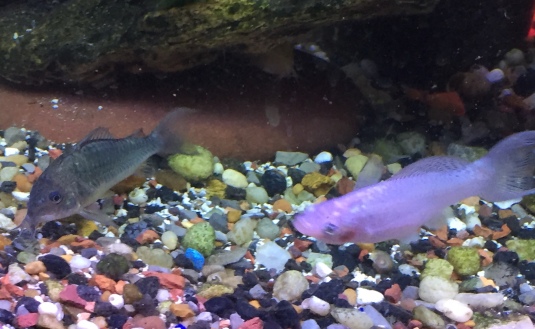
My 75 gallon tank, February 2018. On the left is Kittyfish, an emerald cory catfish I got on 11-9-13. I have had Kittyfish for 4 1/2 years.
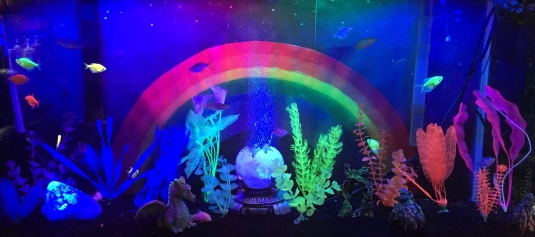
My 55 gallon Rainbow In The Dark tank, February 2018.
I set up this 55 gallon tank in November 2017. In it are 9 tetra glofish. I acquired 5 of them 10-7-16 and got 4 more 1-21-18. There is also one remaining black skirt tetra, from a group I obtained 10-23-14. In the bottom left, by the blue rock and by the dragon, you can see two albino corydoras catfish.
I acquired these two albino corydoras catfish, Marshmellow and Sugar, on 1-15-15. They originally lived in a 29 gallon planted tank with platies and blackline rasboras. I took down the 29 gallon when I got the 55 gallon, and Marshmellow and Sugar went to live in there.
On 12-23-14 I got my first upside down catfish, Coffee. On the left, here she is in April 2015. On Black Friday 2015 I got three more upside down catfish, Donuts, Mocha and Milk. On the right is Coffee with pal Donuts.
Here are the other two upside down catfish, Mocha (left) and Milk. My daughter Naomi named Milk because of the white coloration on his head.
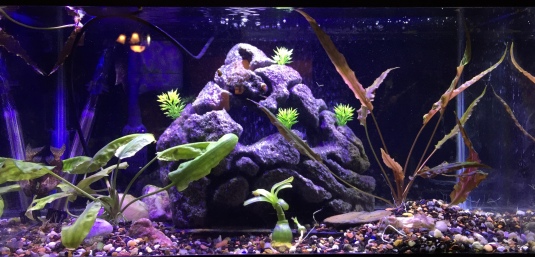
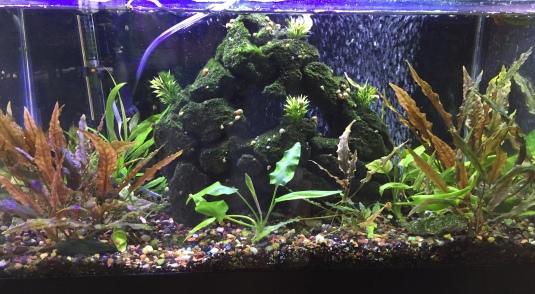
This is the 15 gallon that’s home to the upside down catfish. I took the top photo when I acquired the rock from http://www.stevensonrocks.com in October 2017. The bottom photo was taken 4-21-18.
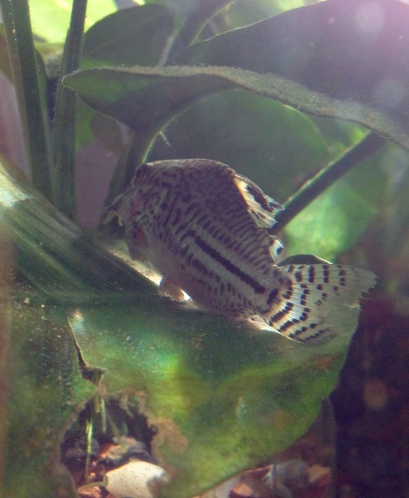
While this fish is no longer with us, he is still worth mentioning. On 6-20-14 I acquired 3 Julii corydoras catfish, and they lived in my 20 gallon planted Chichen Itza tank (see below). This picture was taken 3-25-15. All 3 were still living as of 10-30-16. I believe they died in January 2017.
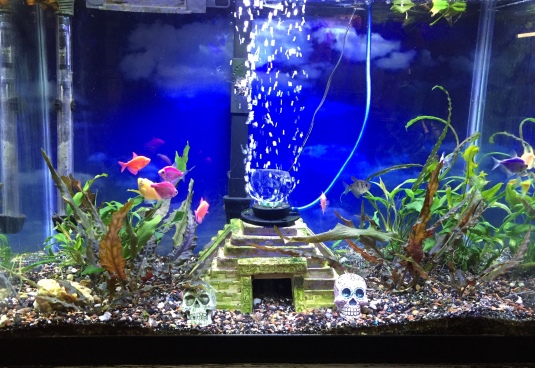
This is my 20 gallon Chichen Itza tank, October 2017. In November 2017 these tetra glofish and the black skirt tetra were moved to the 55 gallon Rainbow In The Dark tank.
So in terms of longevity, the corydoras catfish team appear to be the reigning champs, with Kittyfish in the lead at 4 1/2 years of age. Coming in second are Snowcat and Cloudcat at 3 1/2 years of age, with Marshmellow and Sugar close behind at 3 years 3 months. Team upside down catfish placed second, with Coffee in the lead at 3 years 4 months, and the rest of the team at 2 years 5 months. Team Julii catfish placed third at 2 years 6 months.
Now, onto the bettas. Stay tuned.
17 Feb 2018
by litzi2015
in Aquaponics Blog, Aquarists' Blog, Aquarists' Online Journal, Aquarium Hobbyist Blog, Aquarium Keeping Blog, Aquarium Online Journal, DIY Aquariums, Fish tank blog, Freshwater Aquarium Blog, Home aquarium blog, Planted Aquarium Blog, Tropical Fish Aquarium Blog, Tropical Fish Online Journal, Uncategorized
Tags: aquaponic plan media, aquaponics, charles clapsaddle, DIY aquaponics, DIY planted aquariums, Filtration, goliad farms, indoor gardening, LED aquarium lights, LED grow lights, LED lights, livebearers, Petsmart, planted aquariums, Tropical fish
In doing frequent water changes on my 75 gallon, along with periodic cleaning and maintenance of the filtration systems, I got used to dealing with a lot of green gunk vacuumed out of the gravel and washed out of the filter media. Not wanting to waste anything, I used this to water my house plants. If I had dirty water left over, I poured it into the flower beds outside my front door. I have house plants that are literally older than my children, who are 11 and 17, so this must have been very good for them. There has to be a better way to use this, I thought.
Meanwhile, in the summer of 2017, what was once the vegetable garden was completely overhauled. In the early 2000’s our 750 sq ft garden produced an abundance of tomatoes, bell peppers, cucumbers, salad greens and herbs. In time that changed. Our neighbors’ trees grew larger every year, to the point that the bed was in the shade most of the day. These trees were also evergreens, so the copious amounts of acidic pine needles they dropped didn’t help either.

The veggie garden in better times, July 2012.

The veggie garden facing west, July 2012.
As time went on these trees looked overgrown and half dead. The neighbors to the side of us cut their half dead evergreens down, which helped somewhat but not enough. I tried gently suggesting to the neighbors behind us that their property’s appearance (and market value) would be enhanced if they cut down the half dead trees. Their house was on the market and they were moving to Arizona. “We’ll leave that to the buyers,” they said.
The house behind us quickly sold, and I got to know our new neighbors behind us. I pointed out the half dead evergreens and gently suggested that perhaps it was time for them to come down. “It’s not in our budget, maybe next year,” they said.

Tearing out the veggie garden, August 14, 2017. This was taken at 1:20 pm. You can already see the encroaching shade.

The area had become overgrown. August 14, 2017

The former veggie garden, after we tore everything out, August 14, 2017. This photo was taken on an otherwise sunny day at 1:20 pm, and note how shaded the area is.
So back to aquariums. Now that I had no veggie garden, maybe I could put all that fish waste to use by growing plants in it! There is a name for this–hydroponics or aquaponics.
The idea was to pump dirty fish water out of the tank and into plant growing boxes. The water flows through the plant media and back into the aquarium. I had first heard about this when I saw Charles Clapsaddle of Goliad Farms speak to the Chicago Livebearer Society. He built a canal system which drained dirty water out of his fish barrels and into grow beds for a variety of plants. The water then flowed back into the fish barrels. He managed to run a commercial sized fish farm using no filtration other than plants. https://goliadfarms.com/about/our-methods/
So I started doing research, reading up on DIY aquaponics systems and shopping for suitable equipment. I bought two bags of Top Fin Aquaponics plant media from Petsmart. I bought two 17 inch long plastic planter boxes in olive drab from my neighborhood Ace Hardware. I found a 4 foot long LED grow light on eBay. My husband installed two heavy duty shelf brackets to the cabinet that my 75 gallon tank was on. He got an 18 inch wide shelf and mounted the grow light and an LED aquarium light to the underside of the shelf.
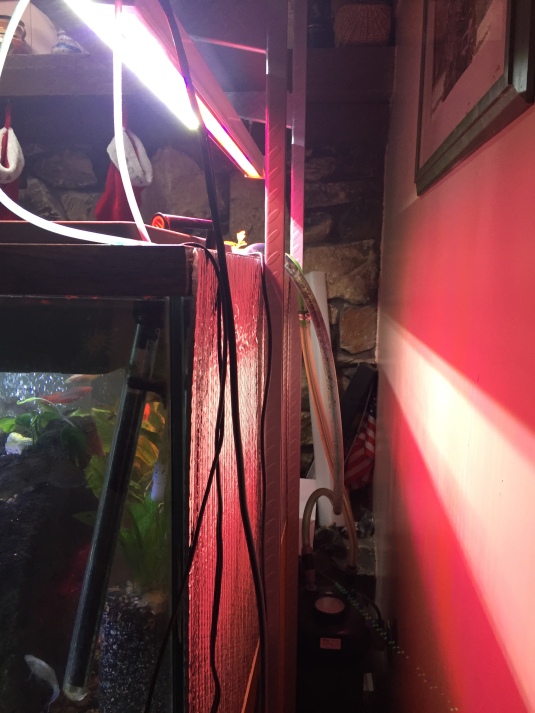
Behind the 75 gallon. These are the shelf brackets my husband installed.
There was one minor problem–the plant boxes were about two inches narrower than the open top of the aquarium. We had to figure out a way to suspend the boxes across the back of the tank, so they wouldn’t fall in. For the time being I positioned the boxes so they were perpendicular to the front and back of the tank, instead of parallel. The distance between the front and back of the 75 gallon was 17 inches, so the boxes could be positioned that way without falling in. The aesthetics were awful. The boxes ran opposite to the position of the grow light. The boxes also created shadows which adversely affected my aquarium plants. Ugh!
Finally, my husband got the idea of getting aluminum u tracks from Menards. He’d cut them to run parallel to the front and back of the tank. The grow boxes had an outer lip, and the u tracking would hold the boxes up.

Here you can see the u tracking holding up the boxes. February 2018.

A nice little tomato sprout in the grow box. February 2018.
I not only needed to supply the grow boxes with light, I had aquarium plants that needed light too. I also had to illuminate the areas underneath the grow boxes which would otherwise be shady. This was crucial since that’s where the aquarium plants were. They were in back, behind the rock decor. They also served to camoflage the tubing from the filters and from the pump that pumped water into the grow boxes.
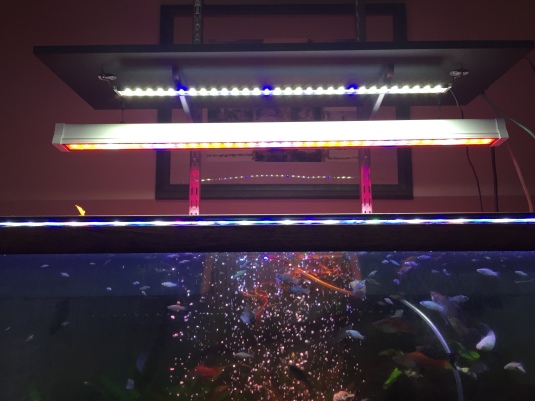
The view from underneath. Mounted to the shelf are the 4 foot long grow light and an 18 inch long LED light. Sitting on top of the tank, running across the front, is a 4 foot long aquarium LED with both day and night settings. I bought all lights new on eBay. The most expensive of the three was the grow light. It was about $60.

The 75 gallon. I added new aquarium plants last weekend. The plant boxes are visible in the upper background. On the upper right is the most recent fish baby boom. February, 2018.
Now, all I have to do is let my tomatoes grow and wait for spring. And figure out what I’m going to do with all those baby fish.
29 Jan 2018
by litzi2015
in Aquarists' Blog, Aquarists' Online Journal, Aquarium Hobbyist Blog, Aquarium Keeping Blog, Aquarium Online Journal, Fish tank blog, Freshwater Aquarium Blog, Home aquarium blog, Keeping Livebearers, Pet fish blog, Planted Aquarium Blog, Tropical Fish Aquarium Blog, Tropical Fish Online Journal, Uncategorized
Tags: Ammonia, Filtration, livebearers, mollies, neon tetras, Nitrates, Nitrites, platies, rasboras, Tropical fish, water changes
A basic biological fact is that every living creature creates waste. Unlike natural waterways, aquariums are closed systems. Anything that goes in, stays in until someone or something removes it. As a result, fish waste, and its toxic byproducts ammonia, nitrates and nitrites, can quickly rise to lethal levels unless they are neutralized or removed. There are two ways to do this–either by replacing the water or filtering it. Most aquarists do both. They run some sort of filtration system and they do periodic water changes. How much water is changed out and how often depends on a lot of things–the size of the aquarium, the number, size and type of fish, and the filtration system. This point is important–ALL FISH NEED A FILTRATION SYSTEM!!!! The only way to go without one is to do constant, and I mean CONSTANT, water changes, if not daily then several times a week. Few things will kill your fish faster and more reliably than dirty water. But as aquarists we don’t want sick or dead fish, we want healthy, living, vibrant fish.
A single betta living in a 1 gallon tank with a Small World bubble filter should get a 50% water change weekly. That same betta residing in a 4 gallon Fluval View, which has a filtration system, should be fine with a 30% water changes every 10 days to 2 weeks. That same betta in a 10 gallon with an appropriately sized hang on back (HOB) filter should be fine with a 30% change every 3-4 weeks.
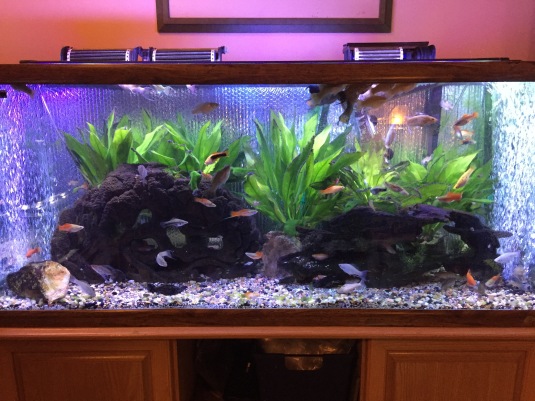
- My overstocked 75 gallon aquarium, July 2017. Look at how green and vibrant those plants are!
Livebearing fish, like guppies, mollies, swordtails and platies, reproduce prolifically. In January 2014 I started my 75 gallon with 4 mollies and assortment of platies, neon tetras and blackline rasboras. Those four mollies have produced at least 15 generations of offspring numbering into the hundreds, most of which I have given away. So with livebearers, a lightly stocked or moderately stocked tank can become quickly overstocked. Overstocked tanks will produce more waste than their filtration systems can handle. At one point I was running a Sunsun 304 5 stage canister filter, a Magnum 350 Pro and a Marineland 200, enough filtration for a 300 gallon tank, and I still had to do 50% water changes with gravel vacuuming at least twice a week. My husband Mike started complaining about the water bill. I needed to find a solution.
Stay tuned…
17 Jun 2017
by litzi2015
in Aquarists' Blog, Aquarists' Online Journal, Aquarium Hobbyist Blog, Aquarium Keeping Blog, Aquarium Online Journal, Divided Aquariums, DIY Aquariums, Fish tank blog, Freshwater Aquarium Blog, Home aquarium blog, Pet fish blog, Planted Aquarium Blog, Tropical Fish Aquarium Blog, Tropical Fish Online Journal, Uncategorized
Tags: bettas, crown tail, Family pets, half moon, socialization, Tropical fish, veiltail
In late 2014 and early 2015 my betta rainbow tank started seeing some line-up changes. Moontail’s black was becoming more prominent, so he wasn’t a blue betta so much anymore. I set up a divided 10 gallon, much like the betta rainbow, and Moontail went in one of the three slots. Moontail shared the tank with Cloudy, a light colored male, and Midnight, a black crowntail female. I called this the Oreo tank. The blue spot in the rainbow was filled by a beautiful blue veiltail we named Hope, after the Hope diamond.
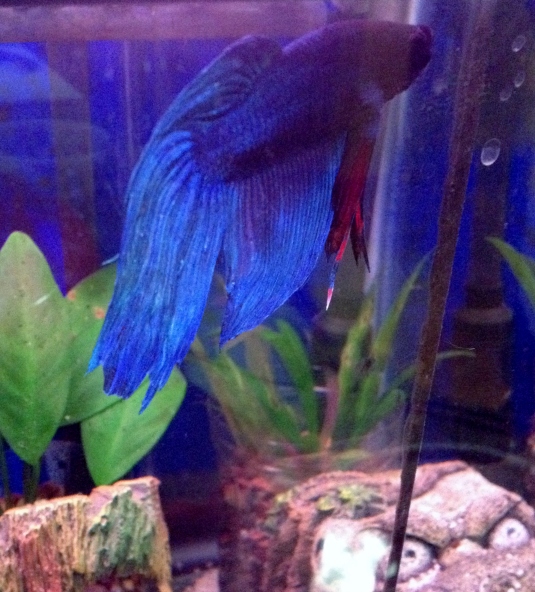
Hope in the blue spot, April 2015
Crescent appeared to be a shy guy and he spent a lot of time hiding, compared to the other fish. I thought he might be happier in a tank by himself, so I moved him to a 1 gallon tank by himself. It proved to be the right decision, and we saw much more of Crescent in his “studio apartment” tank than we ever saw of him in the betta rainbow.
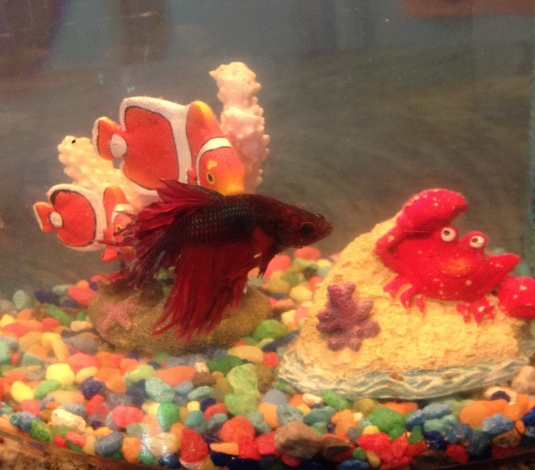
Crescent, November 2014
By then, Mandarin’s color had turned to a dark orange, almost red. I thought he could go in the red slot. My daughter Naomi found a beautiful red, white and blue (later purple) crowntail betta at Meijer, and she named him Patriot. I was having a hard time finding purple bettas so Patriot went into the purple spot.
n January 2015, I lost Crescent, Cloudy and Magenta. I had Crescent for 1 week short of a year and Cloudy for 10 months, but Magenta only lasted 6 months. I found Magenta at Meijer, in a barely half full cup of water so filthy it was almost opaque. I have no idea how long he lived in those conditions or what damage was already done to his internal organs when I got him. But the important thing is he had a good home for 6 months.
In mid January 2015 I found a breathtaking blue and yellow betta we named Bumblebee, and a purple betta we named Magenta Jr. Bumblebee went into the “Oreo” tank in Cloudy’s old spot.
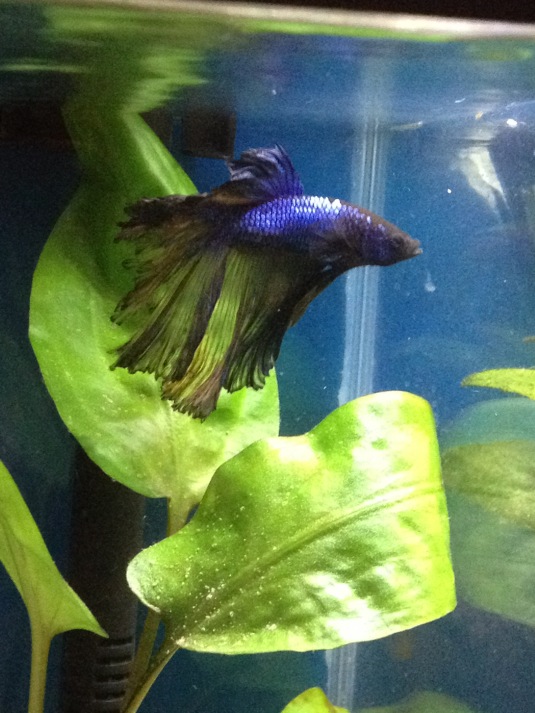
Moontail, in the divided 10 gallon, January 2015
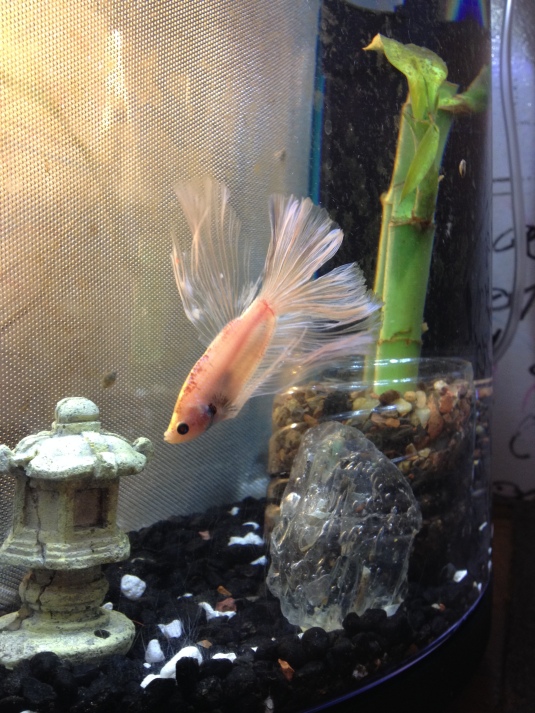
Cloudy, in an earlier black-white divided tank, summer 2014.
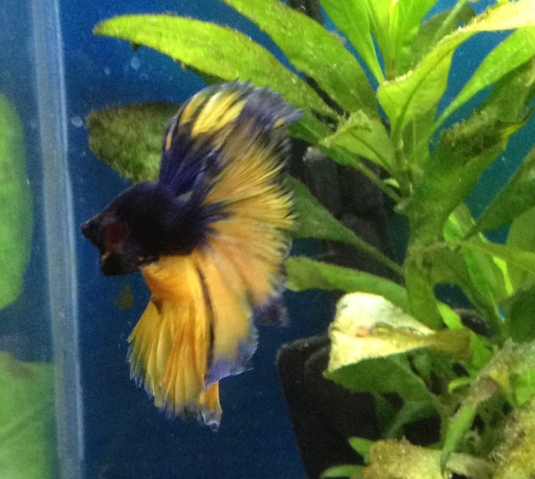
Bumblebee in the divided 10 gallon, January 2015
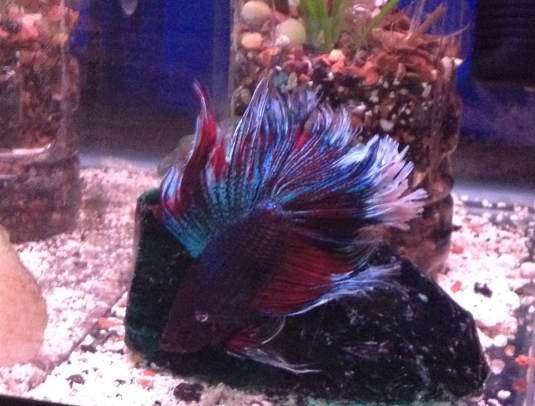
Emerald II occupied the green spot from November 2014 to March 2016.
Magenta Jr. stayed in the Fluval Chi until Mandarin died in March 2015. Then, Patriot moved into the red spot and Magenta Jr. into the purple spot. In April 2015 Mandarin Jr. went into the orange slot. Meanwhile, our yellow betta Colby was looking increasingly haggard. I’d had him almost a year at that point. He was also rescued from Meijer and had outlived his companion Magenta. So I retired Colby to a 1 gallon tank and moved Cheddar to the yellow spot.
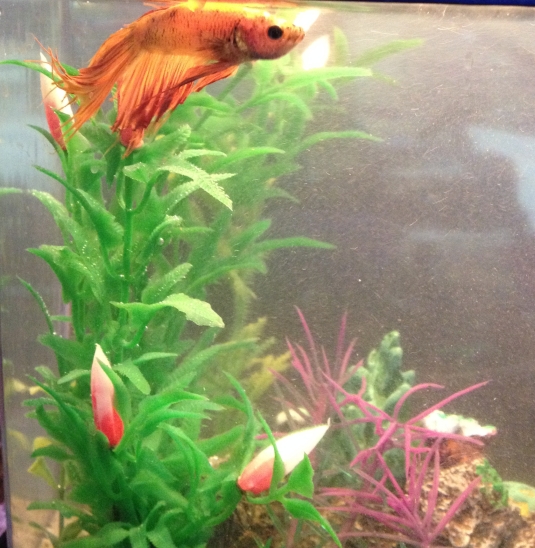
Colby, after his retirement from the Betta Rainbow, April 2015.
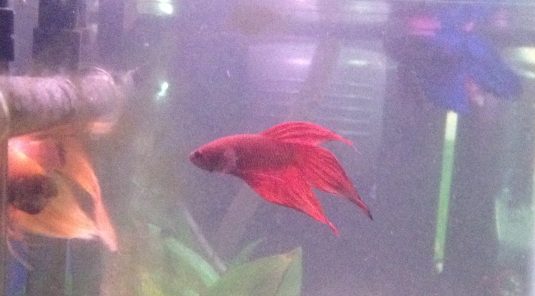
Mandarin Jr., May 2015. He looked more orange when we first got him but his color darkened. To his left is Cheddar, in the yellow spot.
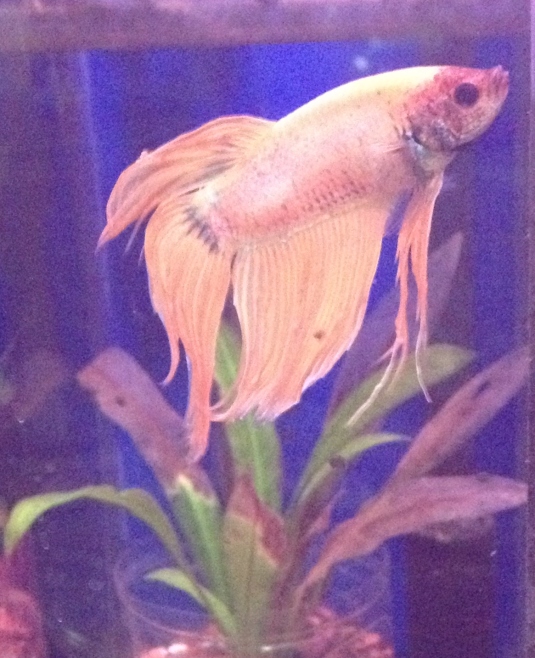
Here is Cheddar in the yellow spot, May 2015.
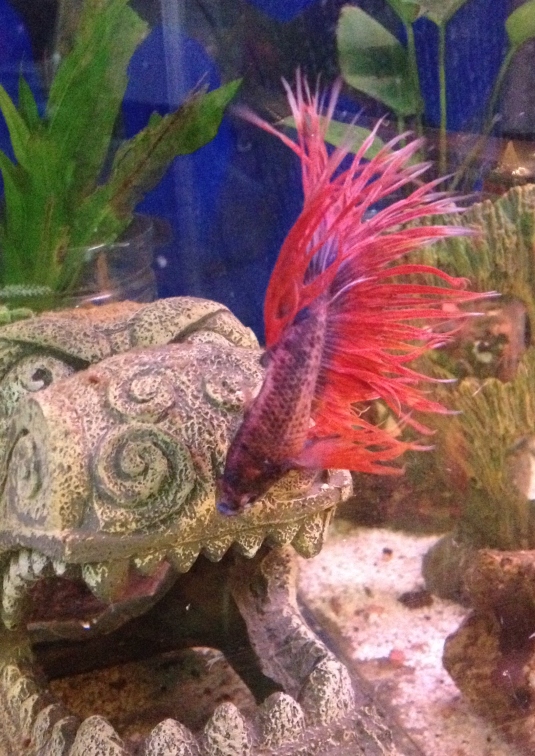
Patriot in the red spot, May 2015
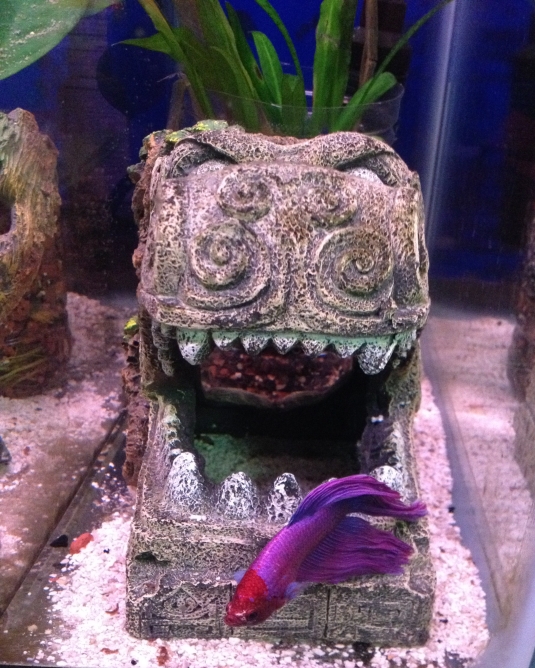
Magenta Jr. in the purple spot, April 2015
Some people predicted that the bettas wouldn’t do well in the divided set-up, that they’d be stressed out from having neighbors. That wasn’t my experience. My longest lived betta was Patriot, who I had for 1 year 10 months and 12 days. I had Cheddar for 1 year 9 months, Moontail for 1 year 7 months, and Emerald II for 1 year, 4 months and 6 days. Even Colby, who had a very rough start at life, lived 1 year.
Everything you know about bettas is wrong. Indeed.
Previous Older Entries






















